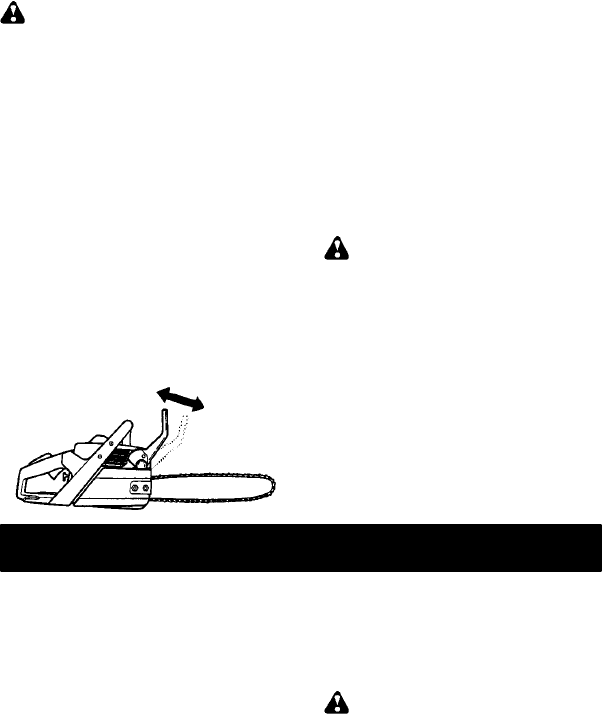
9
CHAIN BRAKE
WARNING: If the brake band is
worn too thin it may break when the chain
brakeis triggered. Withabroken brakeband,
the chain brake will not stop the chain. The
chain brake should be replaced by an autho-
rized service dealer ifany par tis worn toless
than 0,5 mm thick. Repairs o na chain brake
should be made by an authorized service
dealer. Take your unit to the place of pur-
chase if purchased from a servicing dealer,
or to the nearest authorized master service
dealer.
S This saw is equipped with a chain brake.
The brake is designed to stop the chain if
kickback occurs.
S The inertia--activated chain brake is
activated if the front handguard is pushed
forward, either manually (by hand) or
automatically (by sudden m ovement).
S If the brake is already activated, it is
disengaged by pulling thefront handguard
back toward the front handle as far as
possible.
S When cutting with thesaw ,the chainbrake
must be disengaged.
Disengaged
Engaged
Braking function control
CAUTION:
The chain brake must be
checked several times daily. The engine
must berunning when performing t hisproce-
dure. This is theonly in stance when the saw
should be placed on the ground with the en-
gine running.
Place the saw on f irm ground. Grip the rear
handlewithyour righthand andthe f ronthan-
dle with your left hand. Apply full throttle by
fully depressing the throttle trigger. Activate
the chain brake by turning your left wrist
against the hand guard without releasing
your grip around the front handle. The chain
should stop immediately.
Inertia activating function control
WARNING: When performing the
following procedure, the engine must be
turned off.
Grip therear handle with your right hand and
the f ront handle with your lef t hand. Hold the
chain saw approximately 14” (35 cm) above
a stump or other wooden surface. Release
your grip on the front handle and use the
weight of the saw to let the top of the guide
bar fall forward and contact the stump.
When the tip of the bar hit s the stump, the
brake should activate.
CUTTING METHODS
IMPORTANT POINTS
S Check chain tension before first use and af-
ter 1 minute of operation. See CHAIN TEN-
SION in the ASSEMBL Y section.
S Cut wood only . Do not cut metal, plastics,
masonry , non-woo d buildi ng mat erials, etc.
S Stop the saw if the chain strikes a foreign ob-
ject. Inspect the saw and repair or replace
parts as necessary.
S Keep the chain out of di rt and sand. Even a
small amount of dirt will quickly dull a chain
and thus increase the possibility o f kickback.
S Practice cutting a few small logs using the
following techniques to get the “feel” of using
your saw before you begin a major sawing
operation.
S Squeeze t he throttle t rigger and allow the
engine to reach full speed before cutting.
S Begin cutting with the saw frame against
the log.
S Keep the engine at full speed the entire
tim e you are cut ti ng.
S Allow the chain to cut for you. Exert only
light downward pressure. If you f orce the
cut, damage to the bar, chain, or engine
can result.
S Release t hethrottle trigg er a s soon as the
cut is completed, allowing the engine to
idle. If you run t he saw at f ull throttle with-
out a cutting load, unnecessary wear can
occur to the chain, bar, and engine.
S Toavoidlosingcontrol whencut is com-
plete,do notputpressureon saw atend
of cut.
S Stop the e ngine before setting the saw down
after cutting.
TREE FELLING TECHNIQUES
WARNING: Check for broken or
dead branches which can fall while cutting
causing serious injury. Do not cut near build-
ings or electrical wires if you do not know the
direction of tree fall, nor cut at night since you
will not be ale to see well, nor during bad
weather such as rain, snow, or strong winds,
etc. If the tree makes contact with any utility
line, the utility company should be notified im-
mediately.
S Carefully planyour sawing operation inad-
vance.
S Clear the work area. You need a clear area
all around the tree so you can have secure
footing.
S The chain saw operator should keep on
the uphill side of the terrain as the tree is
likely toroll or slidedownhill afterit is felled.
S Study the natural conditions that can cause
the tree to fall in a particular direction.
